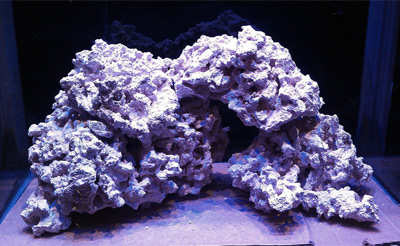 Aquascaping with dry rock has a number of advantages and disadvantagesWhen aquascaping their tanks, marine aquarium hobbyists have the option of using live rock or dry rock (or some combination thereof) to create the foundational reef structure. Each of these options is completely workable but, as with every aspect of this hobby, has its own set of advantages and disadvantages. So how to choose which approach might work best for you given your unique circumstances, budget, etc.? To aid in your decision making, let’s explore the pros and cons of each approach, beginning today with the use of dry rock. I’ll tackle the plusses and minuses of live rock aquascaping in a future post.Pros of dry rock aquascaping Dry rocks tend to be easier on the pocketbook. One reason is that they ship dry so you’re paying only for the weight of the rocks, not the added weight of water as with live rock, and there’s no need to shell out for expedited shipping. Also, the better-quality dry rocks on the market tend to be less dense than live rock, so you get a greater volume of rock for your aquascaping dollar. MORE
Aquascaping with dry rock has a number of advantages and disadvantagesWhen aquascaping their tanks, marine aquarium hobbyists have the option of using live rock or dry rock (or some combination thereof) to create the foundational reef structure. Each of these options is completely workable but, as with every aspect of this hobby, has its own set of advantages and disadvantages. So how to choose which approach might work best for you given your unique circumstances, budget, etc.? To aid in your decision making, let’s explore the pros and cons of each approach, beginning today with the use of dry rock. I’ll tackle the plusses and minuses of live rock aquascaping in a future post.Pros of dry rock aquascaping Dry rocks tend to be easier on the pocketbook. One reason is that they ship dry so you’re paying only for the weight of the rocks, not the added weight of water as with live rock, and there’s no need to shell out for expedited shipping. Also, the better-quality dry rocks on the market tend to be less dense than live rock, so you get a greater volume of rock for your aquascaping dollar. MORE










0 Comments